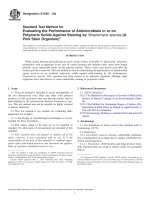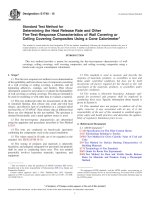Astm e 1386 15
Bạn đang xem bản rút gọn của tài liệu. Xem và tải ngay bản đầy đủ của tài liệu tại đây (72.93 KB, 3 trang )
Designation: E1386 − 15
Standard Practice for
Separation of Ignitable Liquid Residues from Fire Debris
Samples by Solvent Extraction1
This standard is issued under the fixed designation E1386; the number immediately following the designation indicates the year of
original adoption or, in the case of revision, the year of last revision. A number in parentheses indicates the year of last reapproval. A
superscript epsilon (´) indicates an editorial change since the last revision or reapproval.
E1413 Practice for Separation of Ignitable Liquid Residues
from Fire Debris Samples by Dynamic Headspace Concentration
E1459 Guide for Physical Evidence Labeling and Related
Documentation
E1492 Practice for Receiving, Documenting, Storing, and
Retrieving Evidence in a Forensic Science Laboratory
E1618 Test Method for Ignitable Liquid Residues in Extracts
from Fire Debris Samples by Gas Chromatography-Mass
Spectrometry
E2154 Practice for Separation and Concentration of Ignitable Liquid Residues from Fire Debris Samples by Passive Headspace Concentration with Solid Phase Microextraction (SPME)
E2451 Practice for Preserving Ignitable Liquids and Ignitable Liquid Residue Extracts from Fire Debris Samples
1. Scope
1.1 This practice covers the procedure for removing small
quantities of ignitable liquid residue from samples of fire debris
using solvent to extract the residue.
1.2 This practice is suitable for successfully extracting
ignitable liquid residues over a wide range of concentrations.
1.3 Alternate separation and concentration procedures are
listed in the referenced documents (Practices E1388, E1412,
E1413, and E2154).
1.4 This practice offers a set of instructions for performing
one or more specific operations. This standard cannot replace
knowledge, skill, or ability acquired through appropriate
education, training, and experience and should be used in
conjunction with sound professional judgment.
1.5 The values stated in SI units are to be regarded as
standard. No other units of measurement are included in this
standard.
1.6 This standard does not purport to address all of the
safety concerns, if any, associated with its use. It is the
responsibility of the user of this standard to establish appropriate safety and health practices and determine the applicability of regulatory limitations prior to use. For a specific
hazard statement, see 5.5.
3. Summary of Practice
3.1 A sample of fire debris is extracted with an organic
solvent. The extract is filtered and concentrated as necessary.
4. Significance and Use
4.1 This practice is useful for preparing extracts from fire
debris for later analysis by gas chromatography-mass spectrometry (GC/MS).
4.2 This is a very sensitive separation procedure, capable of
isolating quantities smaller than 1 µL of ignitable liquid residue
from a sample.
4.3 This practice is particularly useful when the potential for
fractionation during separation must be reduced, as when
attempting to distinguish between various grades of fuel oil.
4.4 This practice is particularly useful for the extraction of
nonporous surfaces such as glass, or the interior of burned
containers. It is also particularly well suited to the extraction of
ignitable liquid residues from very small samples, very large
samples, or samples that are not suitable for heating.
4.5 This practice is not specific to ignitable liquids and can
be hampered by coincident extraction of interfering compounds present in the fire debris samples.
4.6 This practice may not be useful for the extraction of
some extremely volatile ignitable liquids, which may evaporate
during the concentration step.
2. Referenced Documents
2.1 ASTM Standards:2
E1388 Practice for Sampling of Headspace Vapors from Fire
Debris Samples
E1412 Practice for Separation of Ignitable Liquid Residues
from Fire Debris Samples by Passive Headspace Concentration With Activated Charcoal
1
This practice is under the jurisdiction of ASTM Committee E30 on Forensic
Sciences and is the direct responsibility of E30.01 on Criminalistics
Current edition approved May 1, 2015. Published June 2015. Originally
approved in 1990. Last previous edition approved in 2010 as E1386 – 10. DOI:
10.1520/E1386-15.
2
For referenced ASTM standards, visit the ASTM website, www.astm.org, or
contact ASTM Customer Service at For Annual Book of ASTM
Standards volume information, refer to the standard’s Document Summary page on
the ASTM website.
Copyright © ASTM International, 100 Barr Harbor Drive, PO Box C700, West Conshohocken, PA 19428-2959. United States
1
E1386 − 15
6.1.1 Open and examine the fire debris sample in order to
determine that it is consistent with its description.
6.1.1.1 Resolve any discrepancies between the submitting
agent’s description of the evidence and the analyst’s observation with the submitting agent prior to the completion of the
report.
4.7 This is a destructive technique. Whenever possible, this
technique should only be used when a representative portion of
the sample can be preserved for reanalysis. Those portions of
the sample subjected to this procedure may not be suitable for
resampling. If destruction of the sample is an issue, consider
using passive headspace concentration as described in Practice
E1412.
6.2 Select an appropriate size container to perform the
extraction.
5. Reagents and Materials
5.1 Purity of Reagents—Reagent grade or better chemicals
shall be used in all tests. It is intended that all reagents conform
to the specifications of the Committee on Analytical Reagents
of the American Chemical Society where such specifications
are available.3 Other grades may be used, provided it is first
ascertained that the reagent is of sufficiently high purity to
permit its use without lessening the accuracy of the determination.
6.3 If possible, select a representative portion of the sample
to extract.
6.3.1 Record in the case notes a description of the portion of
the sample extracted.
5.2 Solvent—A suitable single component solvent (polar or
non-polar), with high volatility to allow concentration by
evaporation, such as carbon disulfide, pentane, methylene
chloride, or diethyl ether.
6.6 Mix the solvent and debris. An extraction time of less
than one minute is usually sufficient.
6.6.1 Simple rinsing of nonporous surfaces may be sufficient for adequate extraction of residues.
6.6.2 Multiple small volume extractions may be used; this
technique is more efficient than a single large volume extraction. The multiple small volumes may be combined and
concentrated as necessary.
6.4 Add sufficient solvent to thoroughly moisten the sample.
6.5 A record of the solvent manufacturer, grade and lot
number used shall be maintained.
NOTE 1—Polar oxygenated solvents (such as alcohols) may not be
soluble in non-polar solvents (such as pentane). In order to examine for
the presence of polar oxygenated solvents, it may be necessary to perform
an additional extraction technique, such as analyzing a sample from the
headspace (Practice E1388) prior to performing a solvent extraction.
5.2.1 Check solvent purity by evaporating to at least twice
the extent used in the analysis and analyzing the evaporated
solvent in accordance with Test Method E1618.
5.2.2 Read and follow the safety precautions described in
the safety data sheet (SDS) of the extraction solvent that is
used.
6.7 Decant the solvent and filter if necessary.
6.8 If needed, evaporate the solvent to an appropriate
volume.
6.8.1 Sufficiently concentrated samples do not require
evaporation.
6.8.2 Evaporation techniques may include dry nitrogen,
filtered air, inert gas, vacuum techniques or simple evaporation.
5.3 Filter paper or filter apparatus, free of extractable
hydrocarbons.
6.9 Code or label an appropriately sized vial in accordance
with Guide E1459.
5.4 Beakers, vials, or other extraction containers, free of
extractable hydrocarbons.
5.5 Compressed dry nitrogen, filtered air, or inert gas.
(Warning—These gases are stored under high pressure. )
6.10 Transfer the solvent into the prepared container and
cap.
6. Procedure
6.11 Prepare a system blank to approximate the most
reduced sample. An equivalent amount of the extraction
solvent shall be analyzed (reduced and filtered if necessary) in
the same manner as sample(s) under analysis.
6.1 Observe the appropriate procedures for handling and
documentation of all submitted samples as described in Practice E1492 and Guide E1459.
6.12 Follow the extract storage procedures described in
Practice E2451.
3
Reagent Chemicals, American Chemical Society Specifications, American
Chemical Society, Washington, DC, . For suggestions on
the testing of reagents not listed by the American Chemical Society, see the United
States Pharmacopeia and National Formulary, U.S. Pharmacopeial Convention,
Inc. (USPC), Rockville, MD, .
7. Keywords
7.1 fire debris samples; solvent extraction
2
E1386 − 15
ASTM International takes no position respecting the validity of any patent rights asserted in connection with any item mentioned
in this standard. Users of this standard are expressly advised that determination of the validity of any such patent rights, and the risk
of infringement of such rights, are entirely their own responsibility.
This standard is subject to revision at any time by the responsible technical committee and must be reviewed every five years and
if not revised, either reapproved or withdrawn. Your comments are invited either for revision of this standard or for additional standards
and should be addressed to ASTM International Headquarters. Your comments will receive careful consideration at a meeting of the
responsible technical committee, which you may attend. If you feel that your comments have not received a fair hearing you should
make your views known to the ASTM Committee on Standards, at the address shown below.
This standard is copyrighted by ASTM International, 100 Barr Harbor Drive, PO Box C700, West Conshohocken, PA 19428-2959,
United States. Individual reprints (single or multiple copies) of this standard may be obtained by contacting ASTM at the above
address or at 610-832-9585 (phone), 610-832-9555 (fax), or (e-mail); or through the ASTM website
(www.astm.org). Permission rights to photocopy the standard may also be secured from the Copyright Clearance Center, 222
Rosewood Drive, Danvers, MA 01923, Tel: (978) 646-2600; />
3









